My favourite Chapati (Indian Flatbread) – Roti Recipe. Welcome to this step-by-step guide to making Indian Chapati or Roti like a pro.
Learn how to roll and cook India’s most versatile flatbread. Roti is perfect with all types of daal and curry, as well as alongside many more meals.
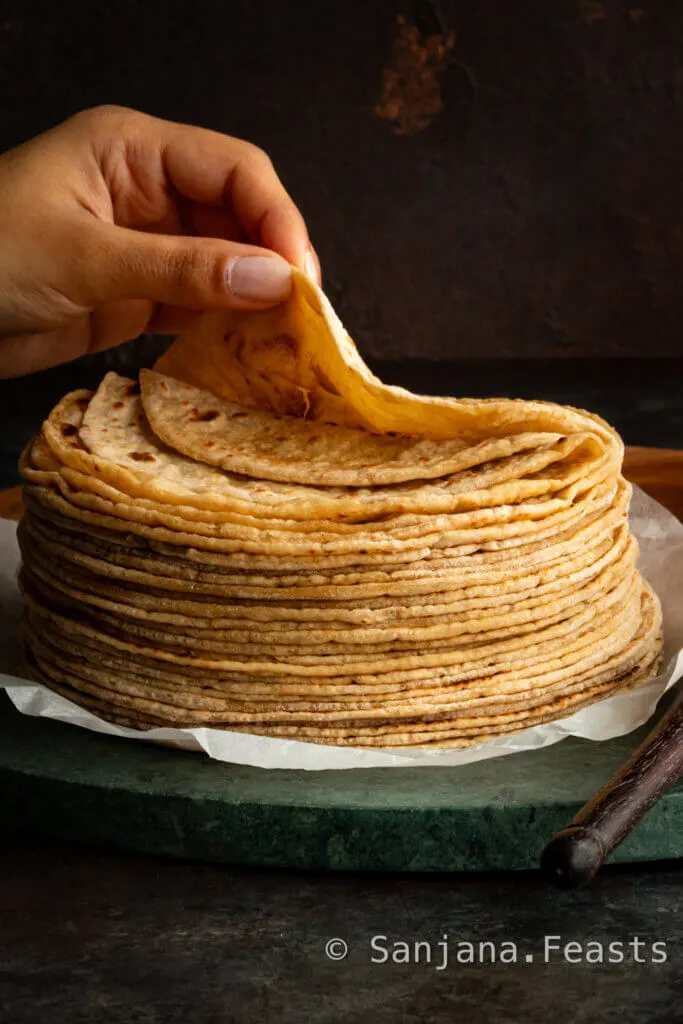
What is Roti?
Roti is a staple food in many parts of the world, especially in South Asia. It’s a type of flatbread that’s made using whole wheat flour (atta), water and oil (optional). But don’t let its simplicity fool you, my friends.
Roti is a true superhero when it comes to satisfying hunger pangs and an essential on the Indian table.
There’s just something magical about the warm, fluffy, and slightly chewy texture of roti. And the aroma of freshly-made roti? Chef’s kiss.

Indeed, the smell that floods a home when the first roti goes on our battered old steel tawa surrounds me with a comfort and joy I cannot even explain.
It’s my most favourite smell in the whole world because it represents my childhood, my family and every moment (both happy and sad) in our home.
Super Soft Roti Recipe – Homemade Indian Chapati
As far as day-to-day cooking goes, chapati (also called roti or rotli) are the glue that sticks everything on the Indian dinner table together. It scoops up curry and daal, pickle and everything in between.
Did you know that roti can be traced back to ancient times? There are even references to it in Sanskrit literature.
Chapatis are everyday staple and without them, a weeknight meal would be incomplete. I’ve known Gujarati folks who won’t touch their dinner unless there are hot, freshly-made roti on the table.
Which flour is best for roti?

The best flour for making Indian roti is wholewheat flour, which is sometimes called ‘atta’. This is a perfect balance of the right texture and flavour for soft roti.
Note that if you use plain (all purpose flour/maida) for roti, they will have a much chewier texture, similar to that of a Roomali Roti.


Atta comes in different grades and the type of milling will affect the end result. Some brands I like are Tesco, East End, Pilsbury and Elephant Atta. I tend to go for ‘Chakki’ or ‘Medium’ mills.
Chakki atta on roti flour packaging simply means that it is a medium-mill wholemeal flour which has undergone extra grinding to make the wheat bran more uniform. This way, you get all the goodness and flavour of the wheat bran, without it tearing due to large or hard flecks in the dough.
What are the different types of Roti?
In Indian cuisine, Chapati come in many different forms. Each region will have a take on it and that take will differ from village to village and home to home.
There are no right or wrong answers when it comes to making chapati – it’s all down to personal choice.
Naming also varies depending on local language and dialect. You can find rotis from South Asia to Malaysia and Africa to the Caribbean.


A handful of different names for this unleavened flatbread (from around the world)
- Chapati (or chapatti)
- Roti
- Phulka
- Rotli
- Safati
- Shabaati
- Roshi
… and so many more
Types of Roti: Phulka



Typically, Phulka (soft, thin, risen chapati) are most common in Gujarati homes. This is the style I grew up eating. We call them Roti at home.
Softer and smaller than your average North Indian-style (tandoor cooked) roti (the kind you get in most Anglo-Indian restaurants), these Phulka have oil in the dough and are cooked on a super-hot steel pan (called a tawa or lodhi). So delicious and toasty!
I don’t often cook my roti over an open flame because they’re so soft, they’d just break. They still puff up like hot air balloons as they cook on the lodhi.
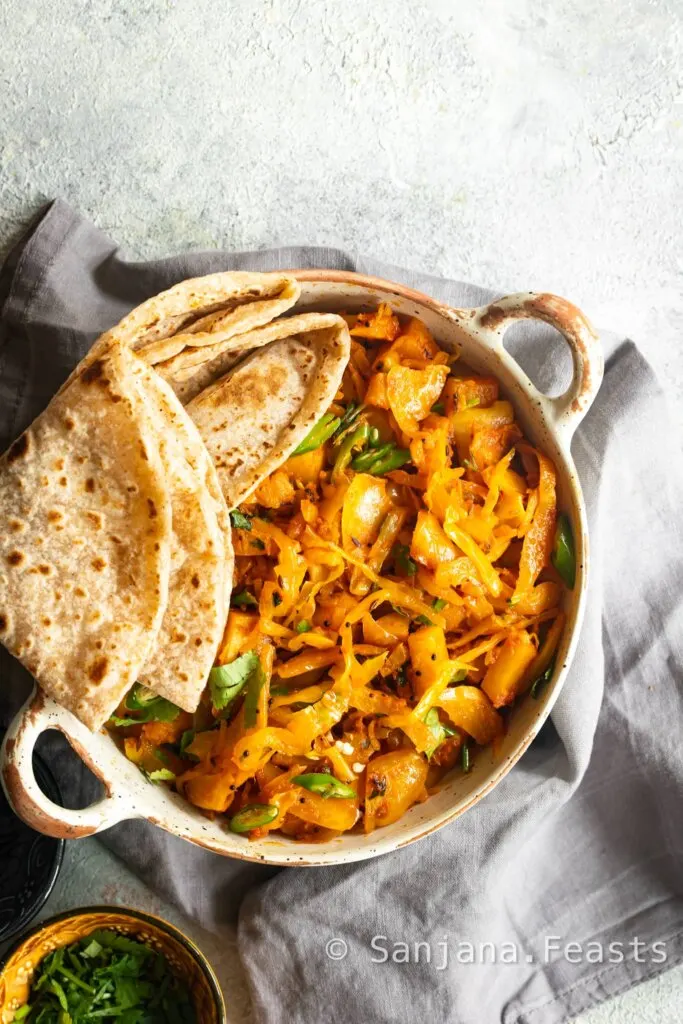

Memories of my mother’s Roti Recipe – Homemade Indian Chapati
They are something I was utterly fascinated by as a child. The first thing I ever ‘cooked’ were raggedy, uneven rotis using my mini roti-making set my aunty bought me when I was five.
Other recipes you might like:
- Soft Spinach Roti recipe
- Paneer Kulcha recipe
- Buttermilk Naan recipe
- Thepla recipe
- Masala Poori recipe
- Aloo Paratha recipe
Roti Recipe – Homemade Indian Chapati: From flatbreads to footballs

I’d peer over our cooker wide-eyed at the hot air balloon show my mum told me was happening. The suspense that built up as they rose from flatbreads to footballs was inexplicably exciting for a little girl obsessed with cooking.
I would roll out the same piece of dough over and over again and by the end of it, my poor dad would have to eat the splat-shaped biscuit thing. It would be presented it to him with such pride. Of course, he’d tell me it was delicious that and I was mastering it. I wasn’t.
Thanks Dad.
How to make this Roti Recipe – Homemade Indian Chapati
There’s a certain routine to making roti you wouldn’t dare mess with. Ask any Indian cook; once their routine is set in its ways, you’d be a fool to question it.
Everything from the patlo (board), to the velan (thin Indian rolling pin) and the tavitho (steel utensil used to flip the roti), to the number of times the roti is actually flipped, a cook’s roti routine is sacred.

Making roti at someone else’s house is literally the worst. “They never rise, the thickness of the velan is all wrong and the lodhi never gets hot enough”, etc, etc, etc. Of course, when it’s you having to explain your flat-as-a-pancake rotis, all these excuses are valid.
How to freeze roti/chapati
I recommend freezing roti after you have rolled them. Place between sheets of parchment paper or food-grade acetate to prevent sticking. Stack the roti one on top of the other and ensure you place a new sheet between each one.
Wrap tightly in foil and freeze. Cook from frozen, do not defrost.
Should roti have butter or ghee?
Everyone has their preferences on whether or not they add butter. I do because life is better with butter.
One of my favourite ways of eating roti is straight off the lodhi, slathered with garlic butter and rolled into a cigar.
This is what my Nanabapu (grandad) would do for my mum when she was little and something she then did for our my brother and I too.
How is Roti different from Naan?
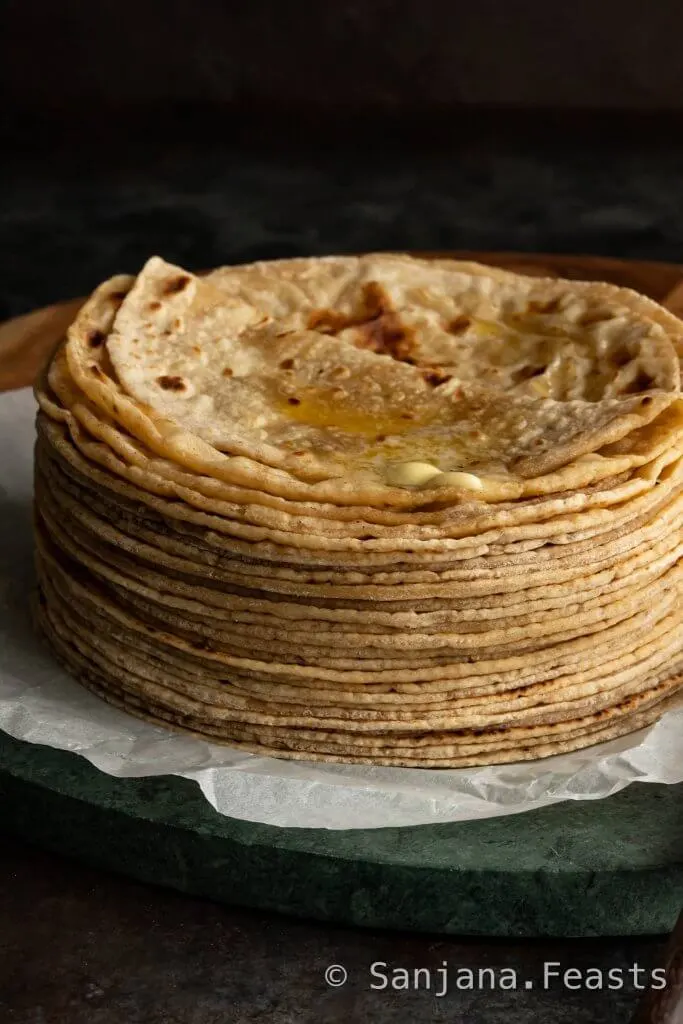
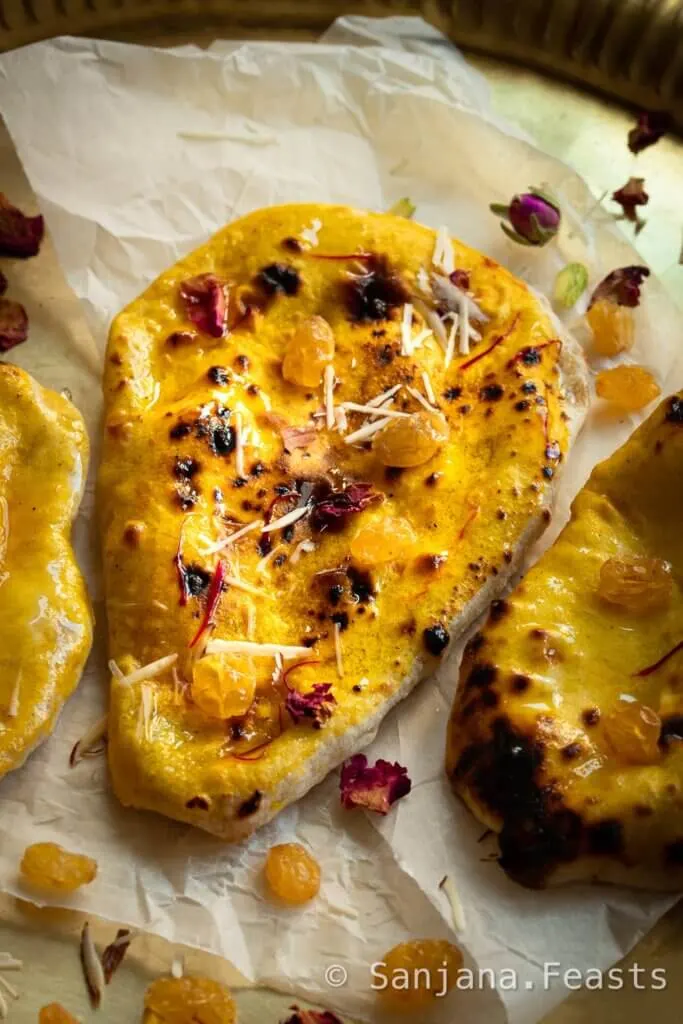
They may look similar and even taste similarly delicious, but there are some notable differences between the two.
First up, let’s talk about the ingredients.
Roti is made with just a few simple ingredients – flour, water, and salt. Naan, on the other hand, has a few more ingredients like yeast, milk, and sometimes even yogurt. The addition of yeast gives naan its signature fluffy texture.
The cooking process is also slightly different. Roti is typically cooked on a tawa, which is a flat griddle, and doesn’t require any oil or butter. Naan, on the other hand, is traditionally cooked in a tandoor, which is a clay oven. This gives it a slightly charred and smoky flavour.
Another difference is the texture. Roti is usually thin and pliable, whereas naan is thicker and more substantial. Naan also has a slightly chewier texture, while roti is soft and fluffy.
Finally, there are some cultural differences between the two. Roti is a staple in many South Asian countries, while naan is a signature dish of the Mughlai cuisine of India and Pakistan.
So, there you have it – while roti and naan may share some similarities, they are indeed different in terms of ingredients, cooking process, texture, and cultural background.
But in the end, let’s be honest, we can’t really go wrong with either option -they’re both pretty amazing!
Is Roti healthier than Naan?
It depends on what you mean by healthy. A piece of roti contains more fibre and fewer calories than a piece of naan, since it is made with whole wheat flour and water.
Naan is typically made with plain flour (all purpose flour/maida), yoghurt and/or milk. Every recipe is different but generally speaking, roti is the lighter option of the two Indian breads. This makes it perfect for everyday eating.
How to roll round chapati
How to roll soft and round chapati. Indian chapati or roti recipe with step-by-step photos. Roti is an amazing, soft and thin flatbread that’s delicious with curry.
- Divide the dough
Take a piece of dough and roll it between your palms, flattening it slightly. Dip each side in flour.
- Create a pocket (my secret to puffy roti!)
Roll it once up and down with the rolling pin and then take a pinch of flour. Place it in the middle of the dough and then use your index fingers and thumb to pinch it closed, starting from the outer edges. This step isn’t something everyone traditionally does but is what my mum taught me for soft roti that rise beautifully.
- Roll the roti!
Now, begin rolling the dough in a circular motion, teasing the dough to move around with your rolling pin. If you can’t do this, pick the roti up with one hand and move it around yourself.
The aim is to create a perfectly round, even surface and a flatbread that’s around 2mm in thickness and 6-7-inches in diameter.
Chapati Recipe – Homemade Indian Roti | Super soft flatbread!
Roti Recipe - Homemade Indian Chapati

How to make soft and round roti. Indian chapati or roti recipe with step-by-step photos. These rotis are delicious with curry and daal.
Ingredients
- 375g wholewheat chapatti flour, (atta), plus more for rolling
- 50ml any cooking oil, vegetable, corn, rapeseed, sunflower etc
- 175ml boiling hot water, or enough to make a soft dough
- Butter or ghee for spreading on the cooked roti
Instructions
- Add the flour to a large bowl and make a well in the middle. Pour the oil into the well and top up with the boiling water.

- Use a spoon to mix the dough until it’s cool enough to handle. Use your hands to bring the dough together. Knead for 5 minutes until smooth and soft.

- Make golf ball-sized pieces with the dough. Keep some flour on a plate for rolling.
- Line another plate with kitchen towel and keep your butter or ghee handy.
- Pre-heat a tawa over medium heat. I use steel but anodised aluminium is great too. Leave it for 5 minutes.
- Get your rolling board and rolling pin ready. Keep a wet tea towel under the board so it doesn’t move around while you roll.
- To start rolling, take a piece of dough and roll it between your palms, flattening it slightly. Dip each side in flour.
- Roll it once up and down with the rolling pin and then take a pinch of flour. Place it in the middle of the dough and then use your index fingers and thumb to pinch it closed, starting from the outer edges. This step isn’t something everyone traditionally does but is what my mum taught me for soft roti that rise beautifully.

- Next, flatten the dough using your palm and again, dip each side in flour. Now, begin rolling the dough in a circular motion, teasing the dough to move around with your rolling. If you can’t do this, pick the roti up with one hand and move it around yourself. The aim is to create a perfectly round, even surface and a flatbread that’s around 2mm in thickness and 6-7-inches in diameter.

- Place the roti on the tawa and cook until little bubbles appear on the surface – around 10 seconds. Flip it.

- Cook it on the second side until small, even brown spots appear all over the bottom of the roti – around 30 seconds. Flip it again.
- Now, this is the rising side. Don’t worry if your rotis don’t rise the first few times you try it. It comes with practice. They’ll still taste delicious. Cook until darker, less evenly-spread patches appear on the bottom. Around 15-20 seconds. Flip it and place it this side up on your kitchen paper-lined plate. Spread with butter or ghee.

- Repeat this process for all of your rotli until you have a perfect stack. You can keep them warm in an insulated container or lidded casserole dish lined with kitchen towel.

Nutrition Information:
Yield: 6 Serving Size: 1 gramsAmount Per Serving: Unsaturated Fat: 0g
How to serve this Roti Recipe – Homemade Indian Chapati
Serve hot with your favourite curry, daal, sambhar, chutney or pickle. I love them with this Melt-in-the-Mouth Burnt Aubergine and Spinach Curry.
One of the coolest things about roti is how it’s made. You gotta get your hands dirty, quite literally, and knead the dough until it’s nice and smooth. Then, you roll it out into thin circles and cook it on a hot griddle until it puffs up. That moment when the roti puffs up into a round ball is just pure magic!
It’s not imperative your rotis rise – they will still taste great! Most importantly, keep practising. It’s so worth it.
Sweet roti, sugar roti, Nutella roti, et al
Did you also know that roti is not only meant for savoury dishes? You can even top it with some sugar, butter or even Nutella and voila, you have a delicious dessert.
How to make Roti fast
Rolling roti comes with practice. However, if you’d like to get ahead with your meal prep, follow these steps for making roti fast. I often make a double batch of roti dough
If you like this Roti Recipe – Homemade Indian Chapati, you’ll love my recipe for Thepla

More delicious Indian bread recipes
Masala Poori recipe

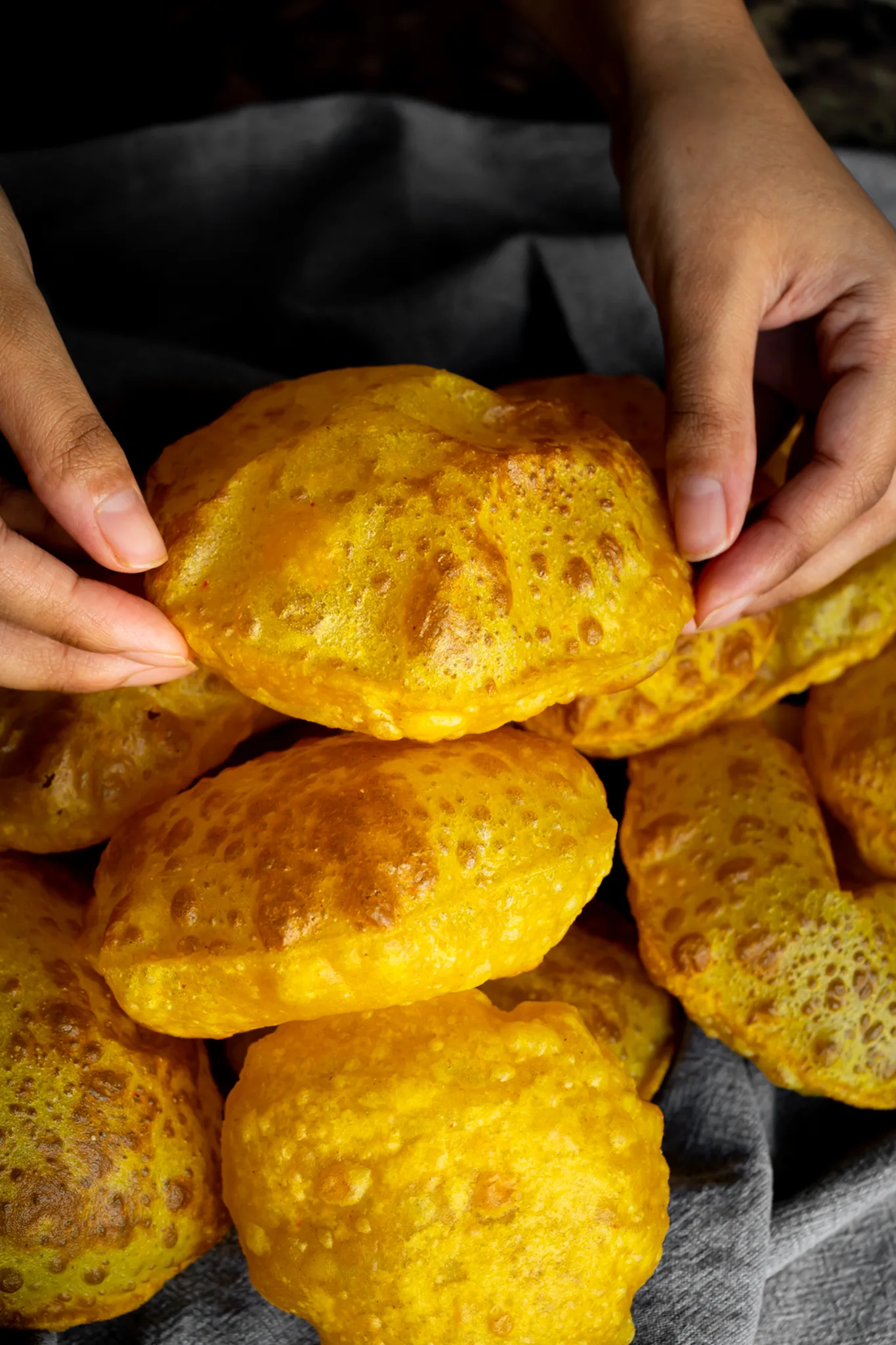

Puffy Masala Poori will forever be a Sunday morning staple. Fried whole wheat flour bread with mild spices, a double layer and hollow middle. The little circles of dough rise before your very eyes for a magical cooking experience — and an even more spectacular eating experience. Here’s my recipe for perfect Masala Poori.
Other types of poori: Plain poori, lucchi, puran puri (puran poli).
Aloo Paratha recipe
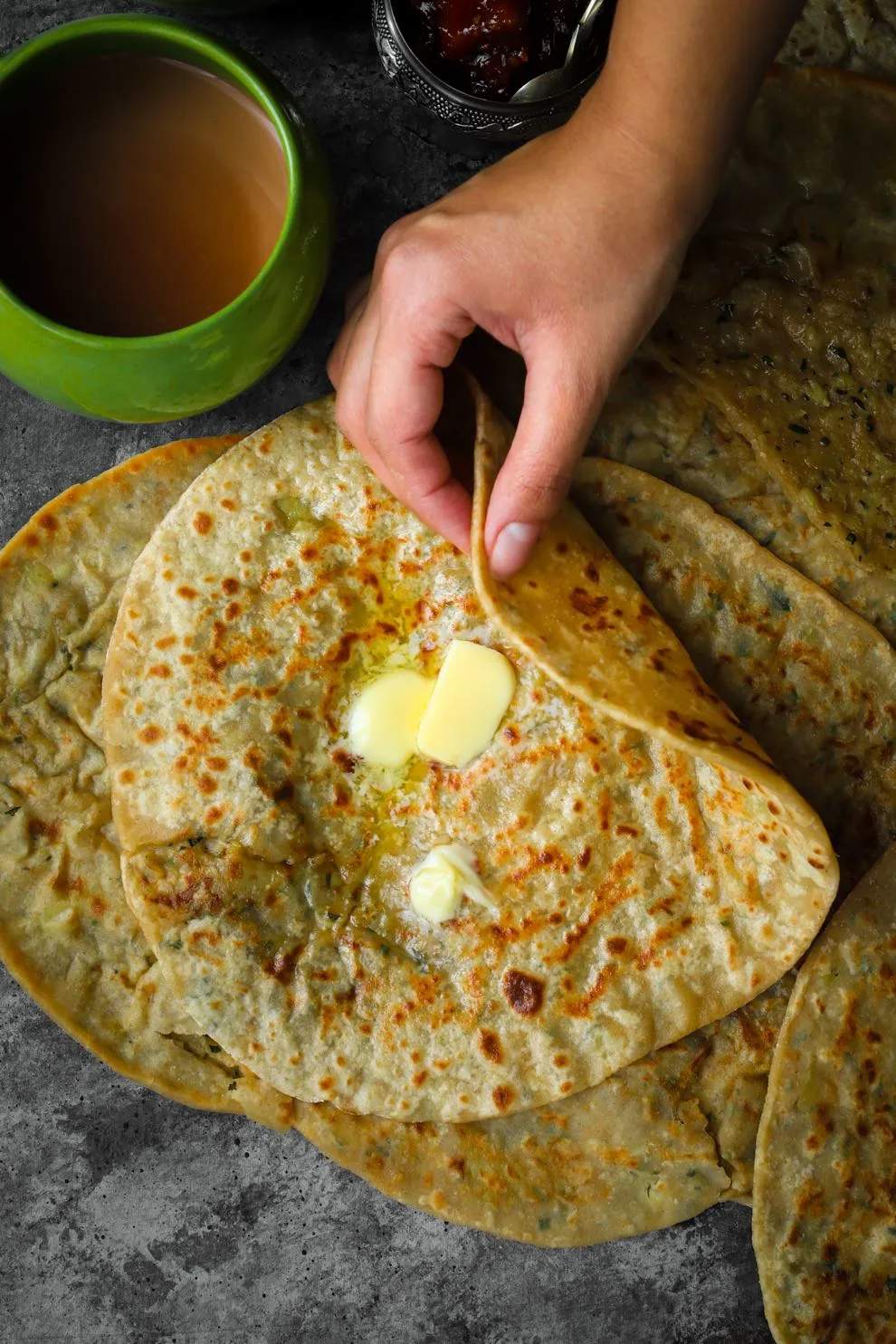


Crispy, flaky Aloo Paratha (Potato-Stuffed Flatbread) are an emblem of soulful Indian home cooking. Almost every home has their own unique recipe and technique for making this delicious North Indian stuffed flatbread. Here’s my recipe for Aloo Paratha.
Other types of paratha: Mooli paratha, laccha paratha, pepper paratha, Malabar paratha, parotta, daal paratha, paneer paratha, keema paratha.
Paneer Kulcha recipe

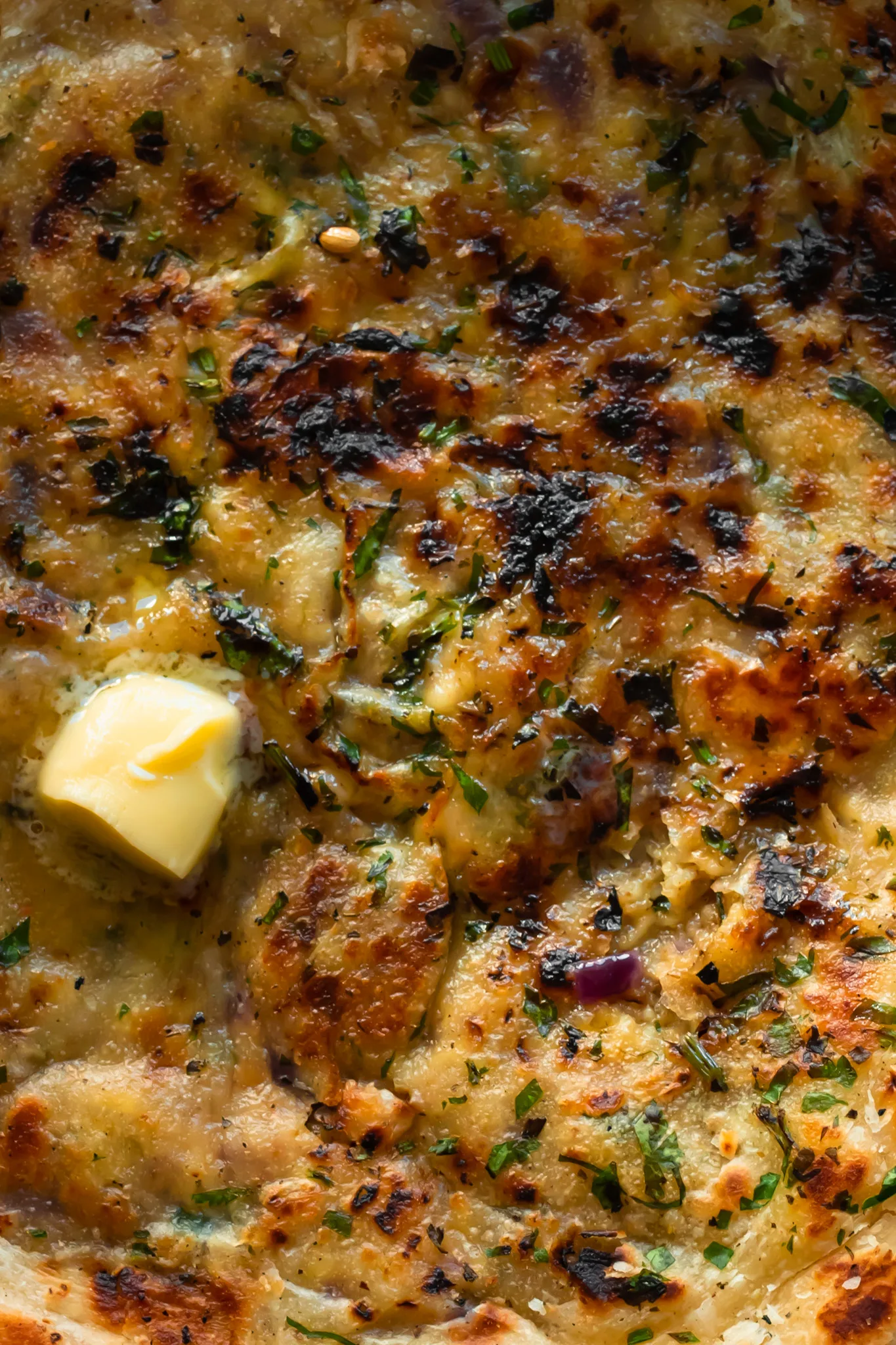

A cross between naan and paratha. Learn how to make ultra-flaky Amritsari-style Paneer Kulcha with me. These flatbreads are famous in North India for their crispy layers of dough and delicious variety of fillings. I stuff my Kulcha with soft paneer, onions, ginger, chillies and a blend of toasted spices. Get the recipe for Paneer Kulcha here.
Other types of kulcha: Aloo kulcha, plain kulcha, matar kulcha, Amritasri kulcha, bread kulcha, cheese kulcha.
Cheese Naan recipe

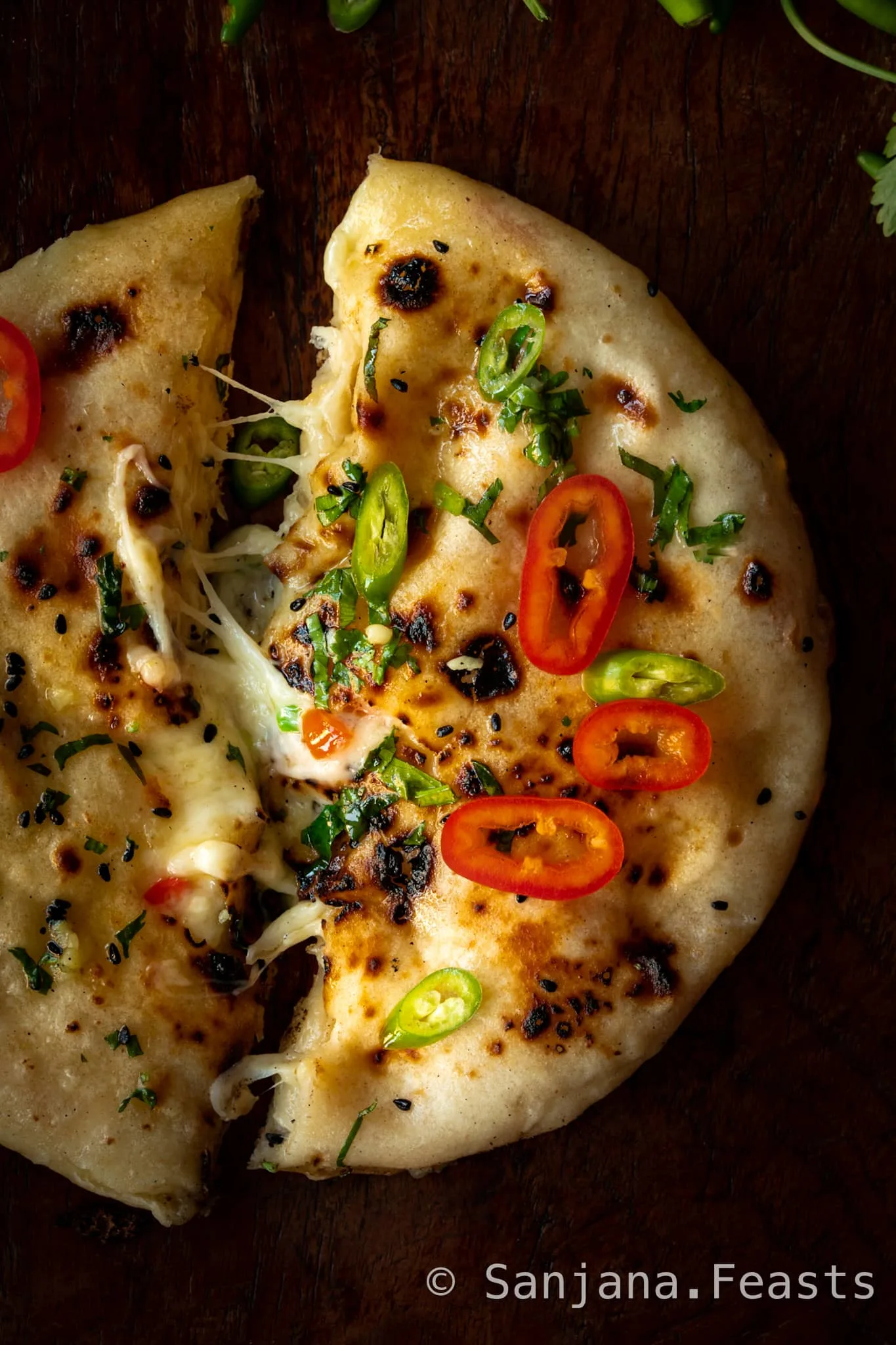
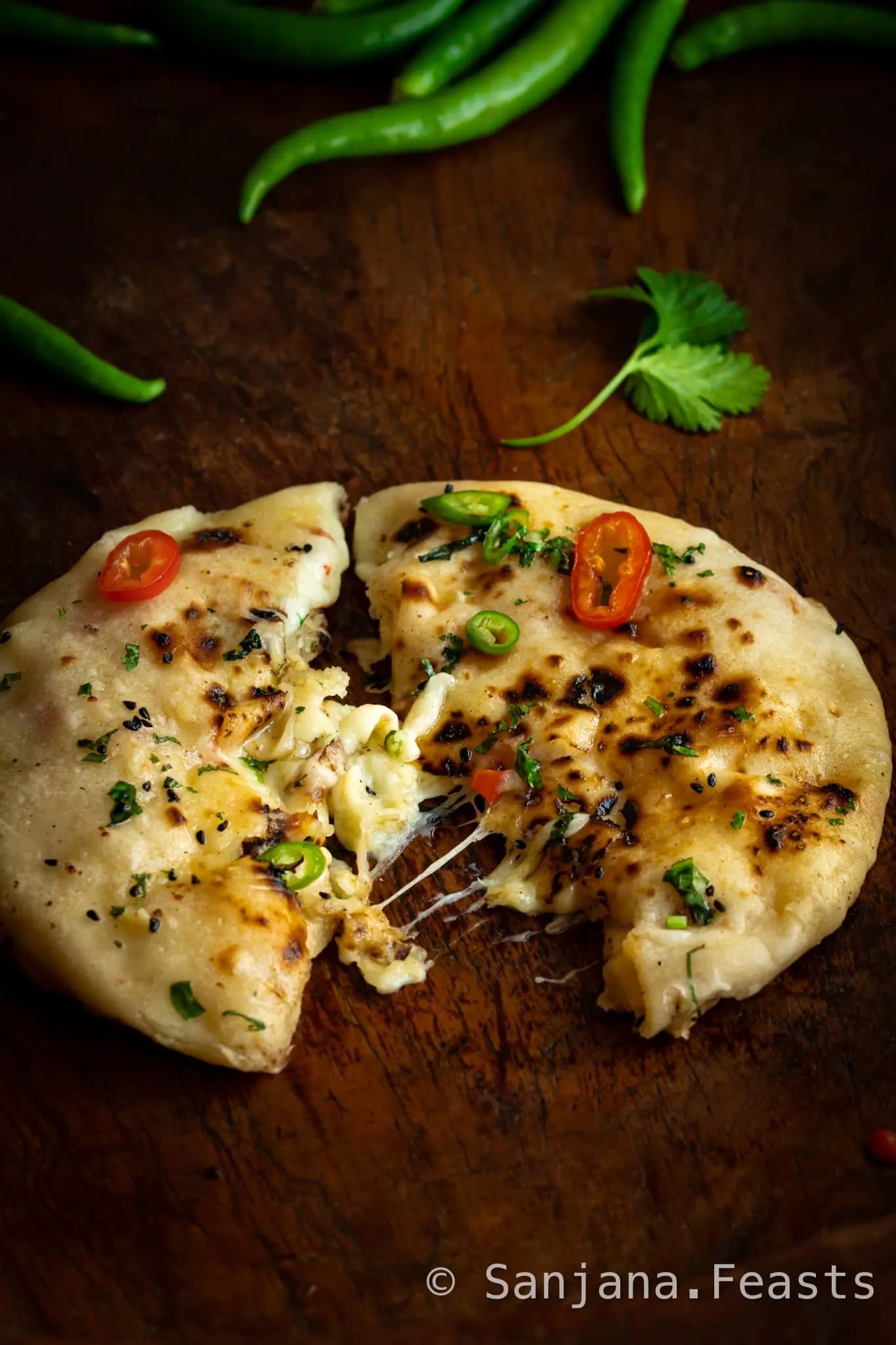
This puffy, blistered Bullet Cheese Naan has a chilli-cheese stuffing and is the softest, most delicious bread for mopping up curry, daal or even eating with your favourite tandoori dishes. This spicy take on cheesy garlic naan is a must for chilli lovers. Grab my Cheese Naan recipe here.
Other types of naan: Garlic naan, chilli naan, chur-chur naan, pudina naan, coriander naan, keema naan, khameeri (yeast) naan, yoghurt naan, Peshawari naan.
Love Sanjana


10 Easy Veg Curries for Roti - Sanjana.Feasts - Recipe Collections
Wednesday 18th of December 2024
[…] are my 10 favourite easy veg curries for roti. From simple classics like Gujarati Okra and Potatoes, to contemporary Tofu Tikka Masala, these […]
Vegan Butter Chicken - Sanjana.Feasts - Indian Curry Recipes
Friday 22nd of November 2024
[…] is a creamy, rich and savoury dish that is hearty and comforting. Serve it with basmati rice, naan, roti, or chapati for a complete […]
Shrikhand Recipe - Sanjana.Feasts - Indian Sweets
Monday 9th of October 2023
[…] Shrikhand with Mung Bean Curry, Kadhi and Rotli for real Gujarati celebration […]
Spinach and Mushroom Curry - Delicious Indian Curry Recipes - Sanjana.Feasts
Thursday 21st of September 2023
[…] buttermilk naan, everyday roti or coconut […]
Mung Bean Curry - Indian Curry Recipes - Sanjana.Feasts
Thursday 27th of April 2023
[…] need some scooping options for this ultra-creamy curry. Rotli, naan, paratha, or even toasted bread rolls are delicious […]